Stand Still for Mounting

A Well-trained Horse Stands Quietly
A horse that constantly moves around when you try to slip your foot in the stirrup is not only frustrating, but potentially dangerous. A well-trained horse stands quietly while you mount and waits for your cue to move off once you’re situated in the saddle. The secret to getting a horse to stand quietly when you go to get in the saddle is to get him to use the thinking side of his brain and tune in to you. Then, if he shimmies away from you when you go to swing up in the saddle, redirect his feet. You’ll make the right thing (standing still while you get in the saddle) easy and the wrong thing (fidgeting) difficult.
1. If you use a mounting block to get on your horse, start by first moving his feet all around the mounting block. Send the horse between you and the mounting block. Stand about 10 feet away from the mounting block and direct the horse’s feet from one side of you to the other. Do this exercise on all four sides of the mounting block. Make the horse hustle his feet the entire time. You want him to think about where he’s putting his feet and get him to tune in to you.
After five to 10 minutes of hustling the horse’s feet, the horse will start to look for a place to rest. Let him rest, but only beside the mounting block. It won’t take long for the horse to realize that the best place to be is beside the mounting block because it’s the only place he’s allowed to rest and get his air back.
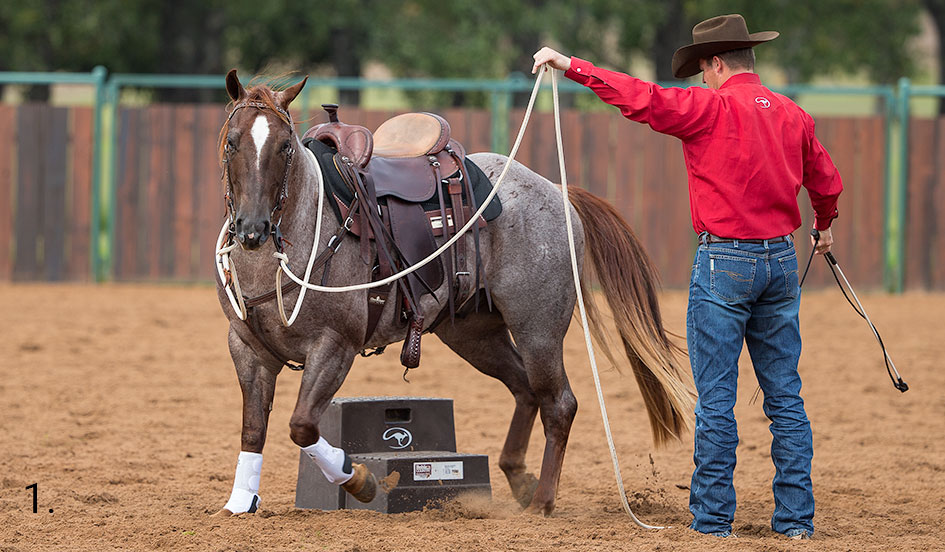
2. Once the horse is quietly standing beside the mounting block, step onto the block and rub him all over his body. Start on his neck and work your way back to his hindquarters. Do this on both sides of his body.
When you’re rubbing the horse, have a lot of feel in your hands. Find his itchy spots. You want him to enjoy standing beside the mounting block. It’s his chance to relax and catch his breath.
3. If he moves away from the mounting block, redirect his feet and put him to work again. Go back to the Sending Exercise, make him back in circles or practice Lunging for Respect. When you make the horse move, really make him hustle his feet. You want him to realize that standing next to the mounting block is easy. What you make him do with his feet isn’t necessarily important; it’s just important to redirect those feet if he decides standing beside the mounting block isn’t the best place in the world.
4. Then put the horse on a big, loose rein and slip your foot into the stirrup and act as if you’re going to get in the saddle. It’s important to put the horse on a loose rein so that you’re not protecting him by making him stand still. Dare him to make the mistake. If you babysit him, he’ll never learn to be responsible.
You want the horse to realize that just because you’re on the mounting block it doesn’t mean you’re going anywhere. Repeat this step on both sides of the horse until he stays standing still beside the mounting block.
If at any point he moves, back him up aggressively and make his feet hustle. You want him to realize that being next to the mounting block is easy and choosing to move away from it results in having to work hard and sweat. After hustling his feet, bring him back to the mounting block and go back to acting like you’re going to get in the saddle.
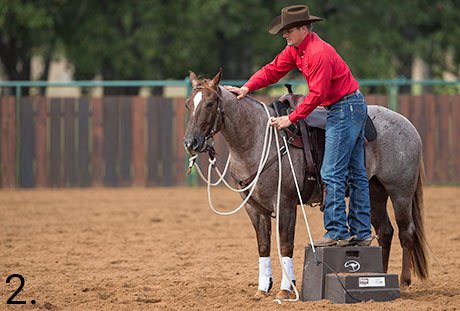

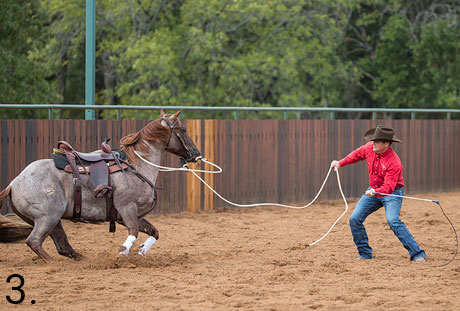
What if I Don’t Use a Mounting Block?
If you don’t use a mounting block to get on your horse, you can still use the same steps I describe throughout the article. Instead of standing on the mounting block, you’ll stand next to your horse, raise your foot, and act like you’re going to mount. If the horse moves, the same concept is still in effect—redirect his feet. Remember, give the horse a reason to want to stand still and relax while you mount. After the horse is comfortable with that, put your foot in the stirrup and step up in the saddle. Step up and down 10 to 15 times on both sides of your horse until he understands that he shouldn’t move every time you put your foot in the stirrup.
5. When the horse is consistently standing still and the furthest thing from his mind is moving off when he’s next to the mounting block, go ahead and get in the saddle.
Once you’re in the saddle, you don’t want the horse to instantly start moving. He’d better stand still until you ask him to move off. People who have trouble with their horses fidgeting when being mounted share a similar habit—they get on their horses and instantly go somewhere. Pretty soon, the horse figures, “Why wait for the rider to tell me to move? I’ll just move when she gets on me. That’s what she’s going to ask me to do anyway.” Then he says to himself, “Why wait for her to get in the saddle? I’ll just start moving when she brings me next to the mounting block.” Before long, the horse won’t even stand still next to the mounting block, or as soon as he sees you raising your foot to get in the saddle, he starts walking forward.
Horses are great at predicting our moves because we fall into habits and rarely change our routines. Rather than inadvertently teaching your horse a bad habit because of your behavior, make a slight change to your normal mounting routine.
6. Once you’re in the saddle, instead of cueing the horse to walk off, spend a few minutes flexing his head and neck. Slide your hand down one rein and then bring it up to your hip. Wait for the horse to give to the pressure and to touch your boot or jeans or the stirrup with his nose. As soon as he does, release the rein. Then slide your other hand down the opposite rein. Bring the rein up to your hip and wait for the horse to soften to the pressure.
Not only is this exercise a quick way to get the horse to check in with you and to ask him to soften to the bridle, but if you do it every time you mount him, he’ll start to anticipate it. Instead of thinking that as soon as you sit down in the saddle he needs to go somewhere, he’ll be thinking about standing still and getting soft. After a few repetitions of flexing his head from side to side, then you can cue him to move forward.
If your horse does walk off before you ask him to, bump on one rein and immediately hustle his feet in a circle. Make him move with energy and work up a sweat. After making him hustle his feet, let him come to a stop and put him back on a loose rein. Dare him to move off again. Make it clear to him: stand still and relax or move and feel uncomfortable. If you’re consistent about correcting him every time he moves off before you ask him to, it won’t take long for your horse to learn to wait for your cue to move.
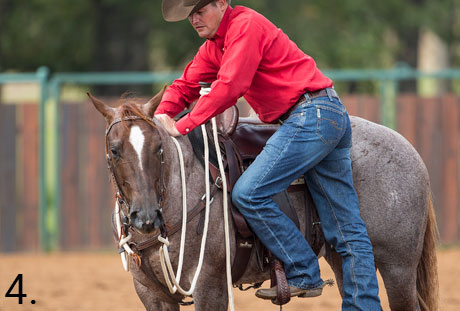
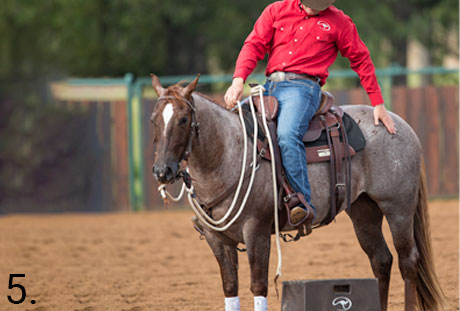
Let Him Commit to the Mistake
The most important thing I want to get across about getting a horse to stand quietly while you mount is to let the horse make mistakes. Don’t make the horse stand still by pulling back on the reins. If he wants to move, let him. You want the horse to realize that standing quietly while you get on is easy. But if he wants to be disrespectful and move around, he’s going to have to work hard. If you concentrate on redirecting his feet every time he goes to move, your horse will be happy to stand still and let you get on and off of him without moving around.
Mount With Consideration
A well-trained horse stands quietly when his rider gets in the saddle, no matter what. However, a good horseman is conscious of how he gets in the saddle. I see many people carelessly jab their knees into their horses’ ribcage, dig their boots into their flanks when they swing up into the saddle or practically drag the saddle down. All of those actions are uncomfortable to a horse and could cause him to fidget when you get in the saddle. Use some care about how you swing up onto his back.
Want To Learn More? SIGN UP FOR OUR LOYALTY PROGRAM
Master your horsemanship training through Clinton’s step-by-step method videos by joining the No Worries Club today. Becoming a club member ensures you get VIP pricing on all of Clinton’s must-have training tools and resources. Plus, you’ll enjoy all the phenomenal benefits that come with club membership!


